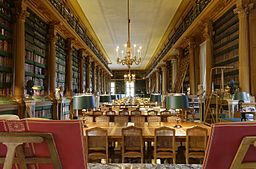Depository Libraries
How do we begin to gather our world’s body of knowledge? How do we ensure that we give credit to all who contribute to it? The intricacies of such far-ranging topics are much too large, and in some ways impossible, to answer, but we do have institutions in place at the heart of these questions. Depository (or deposit) libraries are unique libraries that catalog and classify all copyrightable content produced each year.[1]

The history of depository libraries tells a story of our changing notions of a book’s form, its content, and knowledge itself. The journey to our classificatory systems around the world today marks the transitions in our priorities regarding written knowledge: from gathering knowledge–both idealistically and concretely, to gathering physical books, and finally to organizing and cataloging content under a unified system of classification. These evolutions, including laws of copyright, have laid the foundation for depository libraries around the world; this page will focus on their existence in the United States and its territories.
A Brief History
The basis of book classification as a science is inextricably linked to our social patterns and our habits as evolutionary beings. It has come out of our evolving definitions of knowledge and rights to knowledge, which have been shaped by revolutions in our history.[2]
The Printing Revolution
The advent of printing, made possible by Johannes Gutenberg and his printing press, radically changed the way in which we think about the book and knowledge. Since the seventeenth century, much after the Gutenberg press was invented, bibliographia had come to mean the knowledge of books, notably in a classificatory sense; that is, the process centered on lists, called bibliothecae (libraries).[3] With the boom of printing in the eighteenth century, the new question posed was how to organize, classify, and represent the world of printed knowledge.

The French Revolution
Alongside the printing revolution, the French Revolution was pivotal in shifting bibliography towards a classificatory science of the book, rather than of knowledge. That is to say, focus turned to typography, binding, and paper to create a new, systematic science of the book.[4] Concerning France’s first national library, Bibliothèque Mazarine, upheaval during the French Revolution threatened partial or total destruction.[5] In response, private libraries of aristocrats and clergy were seized, resulting in the dispersal of many collections and, therefore, a need to specify the details of particular volumes closely and systematically.[6] Thus, we were given the organizational and ideological basis for national depository libraries charged with the scientific classification of the book.
Legal Deposit and Copyright
The spread of the book, its production, and finally its organization are all inseparable from changing notions of copyright. As ideas about intellectual property and idea ownership rose, rights began transferring from object to content. The result was a shift further away from the collection of knowledge and books, towards cataloging the text itself.
The emphasis on the processes of collection and a systematic categorization of books contributed to the careful tracking and precise recording of printed content. The Statute of Anne, as the basis for copyright law, predates modern depository libraries; however, the systematic categorization made way for centralized copyright protection. Legal deposit is the requirement that a person or group submit copies of a publication to a repository, and so depository libraries became the sites for recording. In the United States, publishers are required to submit two copies of a copyrightable work to the Library of Congress in what is known as mandatory deposit. In the United States, publication is not actually required to secure copyright, which applies to original works “that are fixed in a tangible form of expression.”[7] This is an important basis for understanding the function, in both a cultural and utilitarian sense, of depository libraries that mediate book classification and book knowledge.
U.S. Depository Resources
Federal Depository Library Program
As a part of its publishing program, the Government Publishing Office (GPO) oversees the Federal Depository Library Program (FDLP), which was created to make U.S. federal government publications available to the public at no cost. The FDLP website outlines the cataloging guidelines and procedures, with a digital navigation map and advanced search resources available to the American public. The website also provides opportunities for individuals to get involved.
National Library
As a country’s preeminent repository of information, a national library functions as the head of book collection and categorization, or the primary depository library. In the United States, the Library of Congress holds the right of transference of all copyrighted works to deposit two copies of books, maps, illustrations, and diagrams printed in the U.S. Holding more than 167 million items, the library developed a system of book classification called Library of Congress Classification, which is also the format used by most U.S. research and university libraries. This system categorizes books scientifically into subtypes within classes, while also being identified by their Library of Congress Control Number (serial number).

It is important to note that the general public does not have access to these archived materials, nor does the library retain every item in its permanent collection. As is true of many similar depository libraries, the Library of Congress retains copies of every publication in the English language that is deemed significant. Therefore, its primary purpose is to serve as a legal repository for copyright protection and copyright registration. Thus, the national library demonstrates how bibliography has shifted towards cataloging the book's content, rather than collecting knowledge or printed copies alone.
Other Libraries
As of March 2018, there are over 1,100 depository libraries in the U.S. and its territories. While the Library of Congress is the largest and most recognized of these, the FDLP provides a digital navigation map and advanced search options for the public to locate Federal depository libraries around the country and its territories.
Digitization
American Memory
The Library of Congress launched its first digitization project in 1990 called “American Memory.” As a public domain website containing 15 million digital objects, American Memory can be consulted directly by librarians all over the world. The library makes determinations about which items to digitize based on the interest for Congress and for the public. Evidently, such prioritization complicates the practice of book categorization as a science of the book rather than of knowledge.
External Links
References
- ↑ Jaeger, Paul T., et al. “The Federal Depository Library Program (FDLP), Academic Libraries, and Access to Government Information.” The Journal of Academic Librarianship, vol. 36, no. 6, 2010, pp. 469–478., doi:10.1016/j.acalib.2010.08.002.
- ↑ Landes, Joan B. “More Than Words: The Printing Press and the French Revolution.” Eighteenth-Century Studies, vol. 25, no. 1, 1991, pp. 85–98. JSTOR, www.jstor.org/stable/2739189. Accessed 11 Dec. 2020.
- ↑ “The Printing Counterrevolution .” Piracy: the Intellectual Property Wars from Gutenberg to Gates, by Adrian Johns, University of Chicago Press, 2011, pp. 213–246.
- ↑ Ibid.
- ↑ Varry, Dominique. “Revolutionary Seizures and Their Consequences for French Library History.” Lost Libraries, edited by James Raven, Palgrave Macmillan, 2004.
- ↑ Ibid.
- ↑ “Copyright Basics,” The United States Copyright Office, May 2012, accessed July 17, 2017, https://www.copyright.gov/circs/circ01.pdf.”